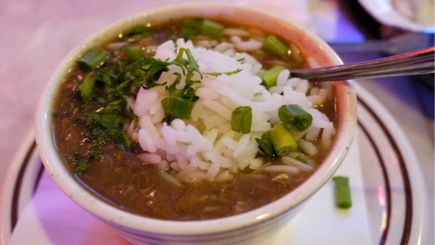The Catholic Foodie’s Best Seafood Gumbo – #SundaySupper

About this time last year I posted my recipe for Seafood Gumbo.
Now, I love gumbo. And I make it quite often. Usually the chicken and andouille variety. Sometimes turkey and andouille. But, seafood gumbo is special. And expensive. So, I usually only make seafood gumbo two or three times a year.
I made a seafood gumbo on Christmas day, and I talked about that on episode 128 of The Catholic Foodie. I changed things up a bit for that gumbo, making some adjustments to my original recipe that really amazed the whole family. My wife even commented that it was the best gumbo (of any type) that she had ever eaten. Wow! That was an awesome compliment!
There were some pretty significant changes I made to the original recipe, so I want to share the new & improved recipe with you now.
I should also mention that seafood gumbo is good not only for Christmas and Thanksgiving, but also for any Sunday Supper (#SundaySupper on Twitter.com).
Bon appetit!
INGREDIENTS
- 4 to 5 lbs shrimp (with heads on), peeled, retain the heads & shells
- 8 yellow onions, 4 chopped, 2 quartered
- 4 ribs celery, 2 chopped, 2 quartered
- 5 green bell peppers, chopped
- 8 to 9 cloves of garlic, minced
- 3 lbs tomatoes, peeled, seeded and chopped
- 1 lb of okra, sliced (1/2-inch slices)
- 1 stick of butter
- 1 cup of olive oil (not extra virgin), or canola oil
- 1 1/2 cup all-purpose flour
- Cayenne pepper, to taste
- 3 bay leaves
- Sea salt, to taste
- Black pepper, freshly cracked, to taste
- 1/2 teaspoon thyme
- 1 bunch of green onions, chopped
- 2 lbs lump crabmeat (or claw meat)
- 2 dozen raw oysters (with their liquor)
- 1 bunch of parsley (flat-leaf), chopped
- Rice
- Crystal Hot Sauce or Tabasco, to taste
METHOD
FOR THE STOCK:
Peel and devein the shrimp, removing the heads. Refrigerate shrimp until ready to use. Place heads and shells in a stock pot. Quarter 4 onions lengthwise. Half a head of garlic. Cut 2 ribs of celery into 3 to 4 inch pieces. Chop 2 bell peppers. Add 2 gallons of water to the stock pot. Bring to a boil, reduce heat and simmer, uncovered, for 2 hours. Strain through fine-meshed sieve. Discard shells and veggies. Return stock to pot and set aside.
FOR THE GUMBO:
- Chop the yellow onions and the celery. Seed, trim, and chop the bell pepper. Set aside. Peel and seed the tomatoes, chop and set aside. (Alternatively, you can use the equivalent in canned tomatoes). Trim and slice the okra into 1/2-inch slices. Set aside.
- Make your roux. Roux is made with equal parts flour and oil. In this recipe, we use a combination of butter and regular olive oil to make the roux. Heat a deep skillet (stainless steel or cast-iron) on medium-high heat (#7.5). Add olive oil to the skillet. Cut up the butter and add to the skillet. When the butter melts and the butter and oil begins to bubble, start adding the flour slowly, stirring constantly with a whisk. Remember to stir constantly to prevent burning or scorching. The roux will quickly change colors. For the gumbo, you want a dark brown roux, the color of chocolate. This should take about 15 minutes.
- Once the roux has reached the right color, quickly add the onions, celery, and bell pepper, continuing to stir (with a wooden spoon) until all is mixed well. Sauté the veggies until they soften, about 3 or 4 minutes. Add the minced garlic and continue to sauté, stirring another minute or two.
- Bring reserved stock to a boil. Add the veggie-roux mixture to the stock using a large spoon. Stir in the spoonful of mixture until fully integrated before adding another spoonful. Add the tomatoes, okra, bay leaves and thyme. Add salt, pepper, and cayenne to taste. Return to a boil, reduce heat and simmer, uncovered, for about an hour or so (even as much as two hours… You’re looking for the roux and the stock to “become one”). Occasionally skim and discard any excess oil that pools on the surface.
- Add the reserved shrimp. Allow to simmer for another 2 minutes. Add the crab meat and the oysters. Simmer for another 2 or 3 minutes, until the edges of the oysters start to curl. Taste and adjust seasoning. Add some of the green onions and the parsley (save some so that each guest can add to their bowl according to taste).
- Remove bay leaves and discard. Serve in bowls over rice. Sprinkle bowls with green onions and parsley. Have Crystal Hot Sauce or Tabasco on hand, and gumbo filé, in case anyone wants to thicken up their bowl with a dash or two.
***Image courtesy of lulu & kame on Flickr.com.***